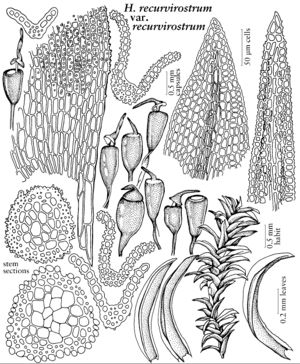Hymenostylium recurvirostrum var. recurvirostrum
Stem hyalodermis variably present, absent especially in depauperate plants. Leaves erect-spreading wet or dry, mostly 1–1.6 (–2) mm, margins narrowly recurved proximally, rarely distally 2-stratose, base not differentiated in shape or ovate.
Phenology: Capsules mature late summer–fall.
Habitat: Calcareous regions, seepy bluffs to moist, seepy ledges and cracks, moist soil along waterfalls, streams and rivers, limestone and calcareous rocks and sediments, cedar barrens (sandstone), forested and more exposed stations
Elevation: low to high elevations (0-1900 m)
Distribution

Greenland, Alta., B.C., Man., N.B., Nfld. and Labr., N.W.T., N.S., Nunavut, Ont., Que., Yukon, Alaska, Ariz., Ark., Calif., Colo., Conn., Fla., Idaho, Ill., Ind., Iowa, Maine, Mass., Mich., Minn., Mo., Mont., Nev., N.J., N.Mex., N.Y., N.C., Ohio, Pa., S.Dak., Tenn., Tex., Utah, Vt., Va., Wash., W.Va., Wis., Wyo., Mexico, West Indies, Bermuda, Central America, South America, Europe, Asia, Africa, Atlantic Islands, Pacific Islands (New Zealand)
Discussion
Leaves of var. recurvirostrum in boreal or arctic areas are regularly strict when wet or dry, smooth and pellucid, characters previously assigned to var. commutatum, and seem to be characteristic only of depauperate morphology. Many of the leaves are deltoid; the stem hyalodermis is also absent and the sclerodermis reduced to one layer, the adaxial stereid layer reduced to only two cells. Collections may have papillae on stems, the papillae often tall (scabrous) or even taller (horrid), and such collections may be named var. scabrum or var. latifolium. This taxonomic designation would be more impressive were there some associated ecological or geographical character, which does not seem to be the case. Variety recurvirostrum is generally treated as one variable taxon throughout the flora area. S. Flowers (1973) recognized two more or less geographically distinct morphological types of var. recurvirostrum in Utah: one with a narrowly and gradually acuminate apex with a wide base with erect-patent to patent leaves, the other more abruptly acute-acuminate, more broad in the distal part of the leaf (as in var. insigne) with leaves squarrose-recurved. It is tempting to read intergradations with var. insigne of British Columbia into Flowers’s description, but every form of intergradation may be found in var. recurvirostrum, including the strongly porose leaf cells so striking in var. insigne. Variety recurvirostrum exhibits every combination of characters of var. insigne, in the thickness and porosity of the lumina, broad to narrow recurvature of the basal leaf margin(s), confined to the leaf base to recurved almost to the apex. The cells are smooth to papillose in every combination, the leaf bases flare or are narrow. Perhaps most consistent characters in var. recurvirostrum are the depauperate, that is, weakly to scarcely developed, costa and the sclerodermis of rather thickened walls in (0–)1–2(–3) rows.
Selected References
None.
